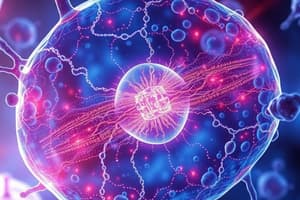Podcast
Questions and Answers
What is the primary source of energy for a cell?
What is the primary source of energy for a cell?
- Actin fibers
- Lysosomes
- Glucose breakdown (correct)
- Cilia
Which organelle is responsible for breaking down worn out components in a cell?
Which organelle is responsible for breaking down worn out components in a cell?
- Flagella
- Lysosomes (correct)
- Mitochondria
- Cilia
What is the function of the plasma membrane in a cell?
What is the function of the plasma membrane in a cell?
- Acting as a storage granule
- Facilitating movement through the environment
- Converting sunlight into energy
- Allowing cell communication through signaling (correct)
Where does glycolysis, the breakdown of glucose, occur within a cell?
Where does glycolysis, the breakdown of glucose, occur within a cell?
Which structure in a cell is involved in propelling the cell through its environment?
Which structure in a cell is involved in propelling the cell through its environment?
What is the lipid bilayer's role in a cell membrane?
What is the lipid bilayer's role in a cell membrane?
What is the main function of the plasma membrane in a cell?
What is the main function of the plasma membrane in a cell?
Which organelle is responsible for energy production in a cell?
Which organelle is responsible for energy production in a cell?
What is the function of ribosomes in a cell?
What is the function of ribosomes in a cell?
Which part of the cell contains most of the genetic information stored in DNA molecules?
Which part of the cell contains most of the genetic information stored in DNA molecules?
What is the primary component of the plasma membrane that forms a semipermeable barrier around the cell?
What is the primary component of the plasma membrane that forms a semipermeable barrier around the cell?
Which part of the cell is mainly composed of water and contains organelles like mitochondria and ribosomes?
Which part of the cell is mainly composed of water and contains organelles like mitochondria and ribosomes?
Flashcards are hidden until you start studying
Study Notes
Cell Structure and Function
Cells are the fundamental units of life, and understanding their structure and function is crucial for comprehending biological processes. Cells have evolved into various forms adapted to different environments and functions. Let's explore some key aspects of cellular design.
Cell Structure
A typical animal cell has three basic parts: the plasma membrane, the cytoplasm, and the nucleus, although other organelles may also exist depending on the type of cell. Here's what each part does:
Plasma Membrane
The outermost layer of the cell, known as the plasma membrane, separates the inside from the outside world while allowing nutrients and waste products to pass through selectively. It consists mainly of phospholipids, proteins, and cholesterol, which form a semipermeable barrier around the cell.
Cytoplasm
Inside the plasma membrane lies the cytoplasm, a jellylike substance made up largely of water containing dissolved salts and sugars that supply the cells with energy for growth and development. Organelles such as mitochondria, which produce energy, and ribosomes, where protein synthesis occurs, are usually found within the cytoplasm.
Nucleus
Protected by a double-layered membrane called the nuclear envelope, the nucleus contains most of the genetic information stored in DNA molecules. This genetic code is used to make proteins and control all activities of the cell.
Additionally, many specialized structures can be present within the cell, including fibers like actin and myosin involved in movement, storage granules for fuel and waste products, lysosomes for breaking down worn out components, and cilia or flagella for propelling the cell through its environment.
Cell Function
Cells perform a wide variety of functions essential for our survival. Some functions, like energy production and respiration, involve basic chemical reactions that generate and utilize life-sustaining energy. Others, like communication between cells via hormones and neurotransmitters, help coordinate behavior among groups of cells.
Energy Production
Energy production typically involves the breakdown of glucose through glycolysis in the cytoplasm followed by electron transport chain activity in the inner mitochondrial membrane, ultimately generating ATP, the cell's primary source of energy. In photosynthetic cells, sunlight drives this process, converting carbon dioxide and water into food (glucose) and oxygen.
Nutrient absorption and molecular synthesis are additional core cell functions supported by the complex machinery found within these specialized structures. These microscopic machines work together to maintain homeostasis and keep the cell alive despite constant stresses from within and without.
Membrane Structure
The lipid bilayer forming the plasma membrane serves several important roles beyond acting as a physical barrier. Its fluidity allows it to adjust to changes in temperature and pressure, facilitating cell shape alterations. Additionally, it acts as a medium for cell signaling, enabling cells to communicate with each other by exchanging signals across the membrane.
The fluid mosaic model explains how specific proteins embedded in the lipid bilayer facilitate signal transduction pathways and other critical cellular functions. For example, receptor proteins embedded in the membrane enable cells to detect and respond to external stimuli, ensuring proper communication between cells and the environment.
Understanding cell structure and function is vital when studying diseases related to disruptions in any aspect of these processes. Diseases resulting from deficiencies in cell structure or impaired cellular mechanisms often have serious consequences, ranging from simple abnormalities to potentially fatal conditions.
Studying That Suits You
Use AI to generate personalized quizzes and flashcards to suit your learning preferences.




